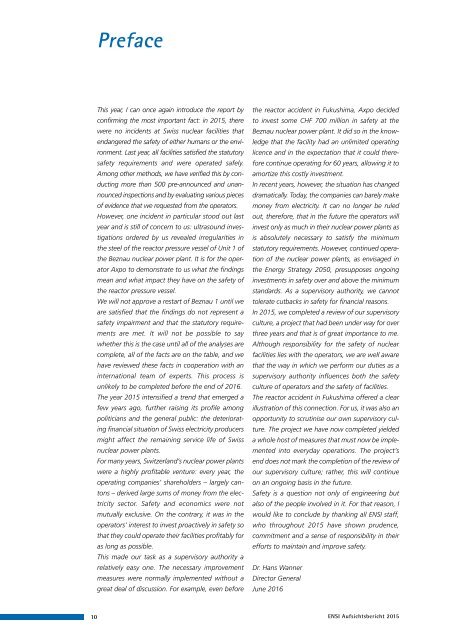Aufsichtsbericht 2015
ENSI_aufsichtsbericht_2015_web
ENSI_aufsichtsbericht_2015_web
Sie wollen auch ein ePaper? Erhöhen Sie die Reichweite Ihrer Titel.
YUMPU macht aus Druck-PDFs automatisch weboptimierte ePaper, die Google liebt.
Preface<br />
This year, I can once again introduce the report by<br />
confirming the most important fact: in <strong>2015</strong>, there<br />
were no incidents at Swiss nuclear facilities that<br />
endangered the safety of either humans or the environment.<br />
Last year, all facilities satisfied the statutory<br />
safety requirements and were operated safely.<br />
Among other methods, we have verified this by conducting<br />
more than 500 pre-announced and unannounced<br />
inspections and by evaluating various pieces<br />
of evidence that we requested from the operators.<br />
However, one incident in particular stood out last<br />
year and is still of concern to us: ultrasound investigations<br />
ordered by us revealed irregularities in<br />
the steel of the reactor pressure vessel of Unit 1 of<br />
the Beznau nuclear power plant. It is for the operator<br />
Axpo to demonstrate to us what the findings<br />
mean and what impact they have on the safety of<br />
the reactor pressure vessel.<br />
We will not approve a restart of Beznau 1 until we<br />
are satisfied that the findings do not represent a<br />
safety impairment and that the statutory requirements<br />
are met. It will not be possible to say<br />
whether this is the case until all of the analyses are<br />
complete, all of the facts are on the table, and we<br />
have reviewed these facts in cooperation with an<br />
international team of experts. This process is<br />
unlikely to be completed before the end of 2016.<br />
The year <strong>2015</strong> intensified a trend that emerged a<br />
few years ago, further raising its profile among<br />
politicians and the general public: the deteriorating<br />
financial situation of Swiss electricity producers<br />
might affect the remaining service life of Swiss<br />
nuclear power plants.<br />
For many years, Switzerland’s nuclear power plants<br />
were a highly profitable venture: every year, the<br />
operating companies’ shareholders – largely cantons<br />
– derived large sums of money from the electricity<br />
sector. Safety and economics were not<br />
mutually exclusive. On the contrary, it was in the<br />
operators’ interest to invest proactively in safety so<br />
that they could operate their facilities profitably for<br />
as long as possible.<br />
This made our task as a supervisory authority a<br />
relatively easy one. The necessary improvement<br />
measures were normally implemented without a<br />
great deal of discussion. For example, even before<br />
the reactor accident in Fukushima, Axpo decided<br />
to invest some CHF 700 million in safety at the<br />
Beznau nuclear power plant. It did so in the knowledge<br />
that the facility had an unlimited operating<br />
licence and in the expectation that it could therefore<br />
continue operating for 60 years, allowing it to<br />
amortize this costly investment.<br />
In recent years, however, the situation has changed<br />
dramatically. Today, the companies can barely make<br />
money from electricity. It can no longer be ruled<br />
out, therefore, that in the future the operators will<br />
invest only as much in their nuclear power plants as<br />
is absolutely necessary to satisfy the minimum<br />
statu tory requirements. However, continued operation<br />
of the nuclear power plants, as envisaged in<br />
the Energy Strategy 2050, presupposes ongoing<br />
investments in safety over and above the minimum<br />
standards. As a supervisory authority, we cannot<br />
tolerate cutbacks in safety for financial reasons.<br />
In <strong>2015</strong>, we completed a review of our supervisory<br />
culture, a project that had been under way for over<br />
three years and that is of great importance to me.<br />
Although responsibility for the safety of nuclear<br />
facilities lies with the operators, we are well aware<br />
that the way in which we perform our duties as a<br />
supervisory authority influences both the safety<br />
culture of operators and the safety of facilities.<br />
The reactor accident in Fukushima offered a clear<br />
illustration of this connection. For us, it was also an<br />
opportunity to scrutinise our own supervisory culture.<br />
The project we have now completed yielded<br />
a whole host of measures that must now be implemented<br />
into everyday operations. The project’s<br />
end does not mark the completion of the review of<br />
our supervisory culture; rather, this will continue<br />
on an ongoing basis in the future.<br />
Safety is a question not only of engineering but<br />
also of the people involved in it. For that reason, I<br />
would like to conclude by thanking all ENSI staff,<br />
who throughout <strong>2015</strong> have shown prudence,<br />
commitment and a sense of responsibility in their<br />
efforts to maintain and improve safety.<br />
Dr. Hans Wanner<br />
Director General<br />
June 2016<br />
10 ENSI <strong>Aufsichtsbericht</strong> <strong>2015</strong>


